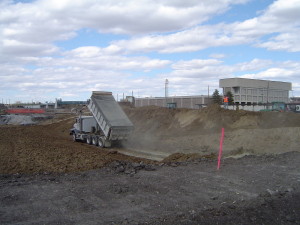Diesel still being sucked out of ground near new Lincoln arena

By Deena Winter | Nebraska Watchdog
LINCOLN, Neb. — Three years after the city began cleaning up a railyard to make room for a new arena, diesel continues to be sucked out of the ground across the street from Lincoln’s year-old $186 million Pinnacle Bank Arena, beneath new restaurants and condos.
THE BIG DIG: Dirty, diesel-soaked soil was excavated and clean soil brought in in 2011, before construction of Lincoln’s new arena began. But diesel continues to be detected on groundwater in monitoring wells near the arena.
In the 1980s, long before the city bought the 67-acre railyard with plans to build the West Haymarket development and its centerpiece arena, a diesel plume the size of a city block was discovered below ground. Burlington Northern Santa Fe Railroad had slowly extracted 11,000 gallons of diesel from the ground by 2010, before the city bought the land, excavated the dirty soil and brought in clean soil in 2011.
The Lincoln arena, restaurants, bars, a hotel, condos, a public plaza and parking garages have since been built in the West Haymarket. But during a follow-up investigation in late 2011, state environmental regulators discovered the cleanup didn’t get all the fuel. Diesel was found on groundwater 15 to 20 feet below ground in a former fueling area. The state ordered the city to start monitoring the fuel with wells and in January the city began sucking it out.
Brian McManus, spokesman for the state Department of Environmental Quality, said the city’s latest quarterly well monitoring report shows diesel was found in three of the six wells. The report shows .11 feet, .44 feet and 2.58 feet of diesel in the wells. The amount has varied since monitoring began one year ago. No diesel has ever been detected in the three other wells.
VAPORS: Years ago an EPA consultant expressed some concern about diesel vapors seeping up to where people would live, work and play.
The city hired a private company, Alfred Benesch & Co., to monitor the diesel and vacuum it out through the end of the year. In its most recent report, the company indicated a new approach may be needed to extract the diesel.
“If the free product (diesel) continues to accumulate rapidly at the end of 2014, an alternate recovery method may be required and NDEQ will be consulted,” the report said.
The cost of cleaning up the railyard was a big campaign issue before Lincoln voters approved proceeding with the West Haymarket development in 2010. Arena opponents predicted the cleanup could cost upward of $100 million, but so far the city has spent $4.7 million of the $7.2 million budgeted for environmental cleanup, according to West Haymarket project manager Paula Portz.
Before the election, an EPA consultant concluded groundwater exposure to diesel was unlikely since the city bans drinking water wells but expressed some concern about diesel vapor seeping into areas where people would live, work and play, particularly through elevator shafts.
The area is now home to restaurants, a hotel, parking garage and condos, but McManus said the vapors aren’t a concern because the diesel is so far from the surface and diesel vapor is less of a concern than gasoline. Even if the diesel were three feet from the surface, it wouldn’t be an issue, he said, and it’s about 15 feet below ground.
City officials have said the diesel is not a threat to humans or the environment because the dirty area was capped with three feet of clean soil.
Once the diesel is gone, the city will be required to continue monitoring the groundwater for a year, McManus said. City officials initially expected to have an all-clear closure letter from the DEQ by the fall of 2012, but that won’t happen until the diesel is gone.
Follow Deena on Twitter at @DeenaNEWatchdog
Editor’s note: to subscribe to News Updates from Nebraska Watchdog at no cost, click here.







